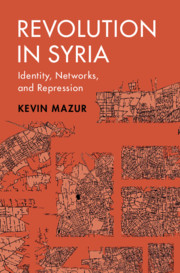Book contents
- Revolution in Syria
- Cambridge Studies in Comparative Politics
- Revolution in Syria
- Copyright page
- Dedication
- Contents
- Figures
- Tables
- Acknowledgments
- A Note on Transliteration
- 1 Introduction
- 2 Theory
- 3 Networks, Identities, and Patronage in Contemporary Syria
- 4 Events of the Syrian Uprising
- 5 Initial Forms of Challenge
- 6 State Networks and Nonparticipation
- 7 Logics of State Repression and Societal Response
- 8 Particularizing Challenge in Kurdish Areas
- 9 Conclusion
- Appendix
- Chronology of Major Events in the First Year of the 2011 Syrian Uprising
- References
- Index
- Series page
6 - State Networks and Nonparticipation
Published online by Cambridge University Press: 18 June 2021
- Revolution in Syria
- Cambridge Studies in Comparative Politics
- Revolution in Syria
- Copyright page
- Dedication
- Contents
- Figures
- Tables
- Acknowledgments
- A Note on Transliteration
- 1 Introduction
- 2 Theory
- 3 Networks, Identities, and Patronage in Contemporary Syria
- 4 Events of the Syrian Uprising
- 5 Initial Forms of Challenge
- 6 State Networks and Nonparticipation
- 7 Logics of State Repression and Societal Response
- 8 Particularizing Challenge in Kurdish Areas
- 9 Conclusion
- Appendix
- Chronology of Major Events in the First Year of the 2011 Syrian Uprising
- References
- Index
- Series page
Summary
This chapter focuses on populations that did not participate in the uprising. It uses quantitative event data to identify sites and local communities that stayed out of contention or entered it significantly later than others with similar characteristics. One of the clearest trends in the data is that non-Sunni communities participated little in the uprising. The chapter highlights the role of mechanisms of “in-group policing” enabled by group-level institutions and networks in generating this quiescence. It then examines mechanisms impelling nonparticipation among segments of the ethnic majority population; the event data indicate that many Sunni Arab localities saw strikingly little contentious activity in the early weeks and months of the uprising. These populations include local communities structured around extended family and tribal networks and individuals linked to the state through its corporatist economic development strategies. Finally, the chapter examines countermobilization, including counterdemonstrations, “popular committees” formed to defend neighborhoods from shadowy enemies, and pro-regime paramilitaries known colloquially as shabbiha.
Keywords
- Type
- Chapter
- Information
- Revolution in SyriaIdentity, Networks, and Repression, pp. 160 - 183Publisher: Cambridge University PressPrint publication year: 2021



